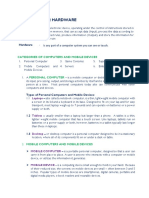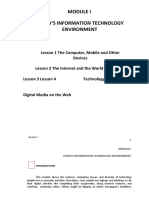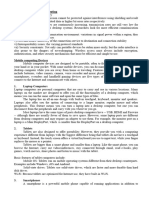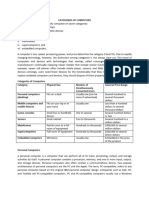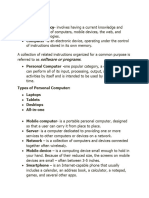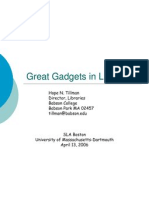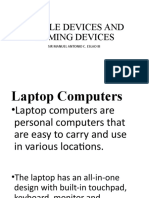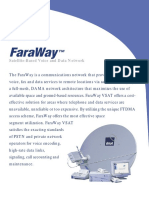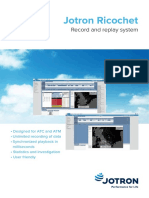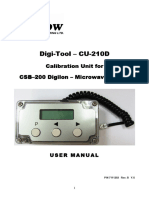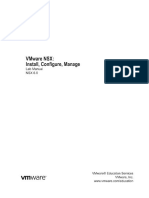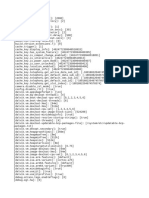Mobile devices are small and lightweight gadgets designed for people who need
to accomplish tasks wherever they are. These are people who need to work on reports and
accomplish tasks but have no access to a desktop computer. Mobile devices are also
referred to as “handheld devices” as people can carry them wherever they go. In short,
these devices are considered portable. These can perform almost all tasks that were
designed for the traditional desktop computers.
In the last 30 years, these devices have become smaller and smaller, yet very
powerful. The following are the types of mobile devices:
MOBILE COMPUTER - A mobile computer refers to a portable device which a person can carry anywhere
he/she goes. You can connect this device to a wireless internet connection, if it is available. It is also described as
small yet durable, provided the user takes care of it properly. Laptops and tablet computers are good examples
of this.
MOBILE PHONE - A common example of a mobile phone is a smartphone. It is commonly touch screen-
operated and can be used for making phone calls and sending text messages. It’s also a kind of cellular phone
that works like a computer. Applications (e.g., games, digital dictionaries, Netflix, Photomath, etc.), be it for
personal or business use, can run on the phone simultaneously. In addition, a user can use it to browse the
internet and store files, take and store photos and videos, record and play music, make use of GPS for location
and navigation, and so much more.
PAGER OR BEEPER - Used in the early 1980’s by people on-the-go, a pager—also called a beeper for the
beeping noise it makes when receiving messages—is a small, one-way telecommunications device that receives
messages for the recipient. However, the recipient cannot reply using his pager/beeper. Anyone who wants to
send a message to another needs to use a landline phone to call a telecommunications operator to relay their
message who in turn will send the message to the recipient’s pager number. Pagers conveniently increased
connectivity among its users during its time. These days, pagers are no longer used because of the innovations in
technology.
DIGITAL CAMERA AND CAMCORDER - A digital camera, or better known as “digicam,” is a device that
captures photographs and stores them in the device’s memory or an external memory card. Unlike old camera
models that use a light-sensitive photographic film, photos can be easily accessed and viewed and do not need to
be “chemically developed”. Big analog camera makers like Nikon, Canon, and Kodak have transformed their
cameras to digital cameras to address the needs of the time.
Big analog camera makers like Nikon, Canon, and Kodak have transformed their cameras to digital
cameras to address the needs of the time.
It took a while though for these camera makers to adapt to these innovations considering they were
popular in the 70’s and 80’s. Nowadays, cameras are being incorporated into smartphones, tablets, and laptops.
However, professional photographers still prefer the high-end, high-definition cameras. Digital video cameras
(video camcorder/digital camcorder), on the other hand, are devices used to record videos. Some of these also
have the capability of taking still pictures.
PERSONAL NAVIGATION DEVICE - Personal Navigation Devices, or PND, are portable devices built to run
Road Navigation applications. In simpler terms, PND helps locate the user.
However, the capabilities of PND is not limited to just locating the user since it also has other
functionalities such as mobile hands-free system, multimedia player, games, external application support, travel
utilities (world time, currency converter, measurement converter, calculator, etc.).
�Learning Competencies: explain the meaning of “mobile device”; distinguish the characteristics of mobile
devices; and differentiate the different kinds of mobile devices.
Name: Date:
CLC: Score:
I. Directions: List down the mobile devices that you have in your bag and at home. Determine its type, its special
features, and its use in your life as an ALS learner.
II. Directions: Try this one! Bookmark three (3) websites that you have searched in the previous activity. (10 PTS)
II. Directions: In your own words, explain the meaning of “Mobile Device.”
____________________________________________________________________________________
____________________________________________________________________________________
____________________________________________________________________________________
Learner’s Signature Date Teacher’s Signature
_____________________________________________________________________________












